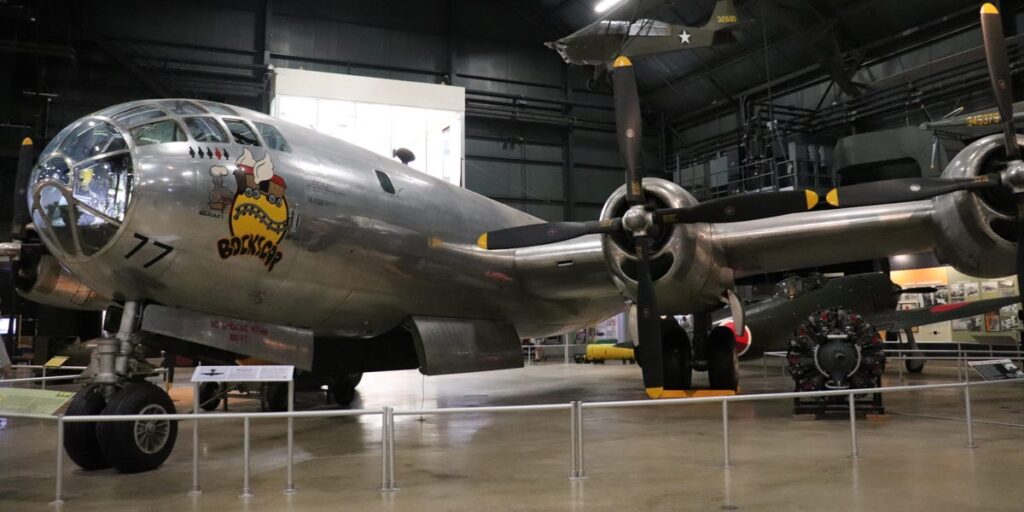X
Bluesky
Copy link
Impact Link
Save
Saved
Read in app
subscribers. Become an Insider
and start reading now.
Have an account? .
- Bockscar, a B-29 bomber, dropped the “Fat Man” atomic bomb on Nagasaki on August 9, 1945.
- The plane is on display at the National Museum of the US Air Force in Dayton, Ohio.
- The museum restored the plane’s nose art and included a recreation of the Fat Man bomb.
The National Museum of the US Air Force in Dayton, Ohio, features around 350 planes and missiles in its collection, but there’s one aircraft in the World War II Gallery that attracts a particularly large crowd.
Bockscar, a Boeing B-29 Superfortress bomber, dropped the Fat Man atomic bomb on Nagasaki in 1945, leading to Japan’s surrender and the end of World War II.
When accompanied by a museum volunteer, visitors can walk under the plane to see where the 10,000-pound bomb was loaded.
I visited the National Museum at the US Air Force in August to see the historic aircraft. Here’s a closer look at Bockscar.
On August 9, 1945, a B-29 bomber called Bockscar dropped the Fat Man atomic bomb on Nagasaki.
The US bombed Nagasaki three days after dropping the “Little Boy” atomic bomb on Hiroshima.
The bombing of Nagasaki initially killed an estimated 40,000 people and injured around 60,000 more, according to the US Department of Energy’s Office of History and Heritage Resources.
Bockscar became known as “the aircraft that ended World War II.”
Japan didn’t surrender after the US dropped the first atomic bomb on Hiroshima on August 6, 1945. After Bockscar dropped a second atomic bomb on Nagasaki on August 9, the emperor of Japan announced their surrender on August 15, bringing World War II to a close.
Additional factors, such as Japan’s weakened military resources and the Soviet Union’s invasion of Manchuria on August 9, are also understood to have contributed to Japan’s surrender.
The bomber arrived at the National Museum of the US Air Force for permanent display in 1961.
The aircraft measures 99 feet long with a wingspan of 141 feet and 3 inches.
It cost $639,000 to build in 1945, which is around $11.6 million in 2025 when adjusted for inflation.
The museum restored Bockscar’s original nose art, which included a boxcar with wings, a mushroom cloud, and a nod to its origins in Utah.
Bockscar was based at Wendover Army Air Field in Utah. The plane flew from Utah to Tinian in the Northern Mariana Islands and then from Tinian to Nagasaki.
The nose art was removed from the plane for the top-secret mission, and its tail markings were changed to indicate the 44th Bomb Group instead of the 509th to disguise its true purpose.
Bockscar was named for its regular pilot, Capt. Frederick C. Bock.
Bock normally flew Bockscar, but switched planes with Maj. Charles Sweeney, commander of the 393rd Bomb Squadron, for the bombing of Nagasaki.
Sweeney had previously piloted another B-29, The Great Artiste, that accompanied the Enola Gay as an observation aircraft during the bombing of Hiroshima.
At Nagasaki, Bock flew The Great Artiste, and Sweeney piloted Bockscar.
When I visited the museum, a volunteer took me underneath the plane to show me where the Fat Man was loaded.
The Fat Man atomic bomb weighed 10,000 pounds and exploded with 20,000 tons of TNT.
A recreation of the Fat Man bomb was displayed next to Bockscar.
The museum refurbished a demilitarized Mk III bomb to look like the Fat Man, which was painted yellow so that it could easily be seen after it was dropped.
The museum also included photos of the bomb’s devastating impact.
Lt. Charles Levy took this colorized photo of the Fat Man’s explosion from aboard The Great Artiste. The mushroom cloud rose over 60,000 feet in the air.
The exact number of people who died in the bombings of Hiroshima and Nagasaki will never be known. According to the Bulletin of the Atomic Scientists, the “low” estimate shared by the US military in the 1940s counted 70,000 deaths at Hiroshima and 40,000 at Nagasaki, totaling 110,000. The “high” estimate, which anti-nuclear weapons scientists and Japan released in the 1970s, counted 140,000 deaths at Hiroshima and 70,000 at Nagasaki for a total of 210,000 lives lost.
Read the full article here


